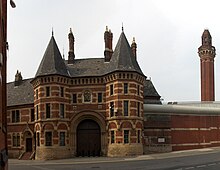HM Prison Manchester
 |
|
| Location | Strangeways, Manchester |
|---|---|
| Security class | Adult Male/Category A |
| Population | 1269 (as of August 2008) |
| Opened | 1868 |
| Managed by | HM Prison Services |
| Governor | Terry Williams |
| Website | Manchester at justice.gov.uk |
HM Prison Manchester (commonly known as Strangeways) is a high-security male prison in Manchester, England, operated by Her Majesty's Prison Service. It is a local prison, holding prisoners remanded into custody from courts in the Manchester area and Category A prisoners (those whose escape would be highly dangerous).
Strangeways was designed by Alfred Waterhouse and opened in 1868 alongside the now destroyed Manchester Assize Courts. The prison is known for its prominent ventilation tower and imposing design, structured by the principles of the separate system.
HM Prison Manchester was known as Strangeways, after the area in which it is located, until it was rebuilt following a major riot in 1990 and is still commonly referred to as such.
Construction of the Grade II listed prison was completed in 1869, and it was opened on 25 June 1868, to replace the New Bailey Prison in Salford, which closed in 1868. The prison, designed by Alfred Waterhouse in 1862 with input from Joshua Jebb, cost £170,000, and had a capacity of 1,000 . Its 234 feet (71 m) ventilation tower (often mistaken for a watchtower) has become a local landmark. The prison's walls, which are rumoured to be 16 feet thick, are said to be impenetrable from either inside or out.
The prison has an element of the separate system with its plan in the form of a star or a snowflake, with two blocks housing ten wings that emanate from a central core where the watchtower is situated. The prison consists of two radial blocks branching from the central core with a total of ten wings (A, B, C, D, E, F in one block, and G, H, I, K in the second).
The jail was built on the grounds of Strangeways Park and Gardens, from which it was named. Strangeways was recorded in 1322 as Strangwas from the Anglo-Saxon Strang and gewæsc meaning "[a place by] a stream with a strong current".
...
Wikipedia
